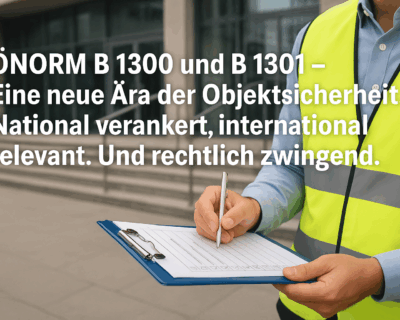Safety compared to aviation - Fire Protection Austria

Aviation is one of the safest industries in the world. Despite the high level of complexity and enormous risks, airlines and aviation authorities manage to guarantee a remarkable level of safety. But why does this work so well? What principles, methods and strategies does aviation use, and how can we transfer these findings to other areas such as fire protection, occupational health and safety, corporate management and general safety?
1. standardized processes and checklists
In aviation, safety begins before the flight. Pilots systematically work through an extensive checklist. Each activity is clearly defined and worked through point by point to avoid errors.
Transferability to companies:
- Development and consistent use of checklists for maintenance, inspections and audits.
- Standardized processes in production, warehousing and administration.
2. clear communication
Communication in aviation is short, clear and binding. This prevents misunderstandings and increases the speed of response, especially in emergencies.
Transferability to companies:
- Introduction of clear communication guidelines and channels, especially in crisis situations.
- Training managers and employees in clear communication and active listening.
3. practiced error culture
The aviation industry cultivates an open and constructive error culture. Errors are systematically analyzed without apportioning blame. The aim is always to avoid similar incidents in the future.
Transferability to companies:
- Introduction of an open error culture in order to quickly identify and rectify weaknesses.
- Establish regular feedback and learning sessions after incidents.
4. regular training and simulations
Pilots and crew members undergo continuous training and realistic simulations in order to be optimally prepared for all situations.
Transferability to companies:
- Carrying out regular safety and emergency training (e.g. fire drills, first aid).
- Simulate realistic scenarios for crisis management and evacuation.
5. responsibility and clear responsibilities
Responsibilities are clearly defined in every aircraft. Everyone knows exactly what tasks they have to perform. This reduces stress and increases efficiency in critical moments.
Transferability to companies:
- Clear definition and allocation of responsibilities and competencies.
- Clear definition of substitution rules, especially in crisis situations.
6. redundancy and backup systems
Backup and redundancy systems are a key safety factor in aviation. If one system fails, another is immediately available.
Transferability to companies:
- Development and maintenance of alternative systems for critical processes (e.g. emergency power supply).
- Regular inspection and maintenance of these backup systems.
7. continuous improvement process
Aviation is constantly evolving. New technologies, processes and findings are constantly being integrated to further increase safety.
Transferability to companies:
- Implementation of a continuous improvement process (CIP) in all safety-relevant areas.
- Active involvement of employees in the process of identifying and implementing potential for improvement.
8. technical inspections and maintenance
Aviation relies on regular, thorough and documented maintenance to prevent breakdowns and guarantee safety.
Transferability to companies:
- Creation of detailed maintenance and inspection plans for technical systems.
- Consistent documentation of all maintenance work and checks carried out.
Summary
The safety principles of the aviation industry are extremely effective and exemplary in their clarity and efficiency. Standardized processes, clear communication, consistent training and a practiced improvement process ensure an exceptionally high level of safety in aviation. These proven principles can be used by companies across all industries to reduce risks, avoid errors and ultimately improve not only safety, but also quality and efficiency in operations in the long term.
Companies that learn from aviation not only benefit from increased safety, but also strengthen their competitiveness and ensure their long-term economic success.




